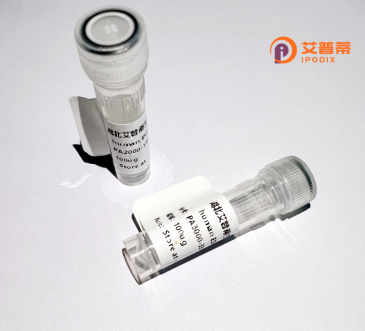
| 纯度 | >90%SDS-PAGE. |
| 种属 | Human |
| 靶点 | BTBD11 |
| Uniprot No | A6QL63 |
| 内毒素 | < 0.01EU/μg |
| 表达宿主 | E.coli |
| 表达区间 | 1-183aa |
| 氨基酸序列 | MSDVTFLVEGRPFYAHKVLLFTASPRFKALLSSKPTNDGTCIEIGYVKYSIFQLVMQYLYYGGPESLLIKNNEIMELLSAAKFFQLEALQRHCEIICAKSINTDNCVDIYNHAKFLGVTELSAYCEGYFLKNMMVLIENEAFKQLLYDKNGEGTGQDVLQDLQRTLAIRIQSIHLSSSKGSVV |
| 分子量 | 47.1 kDa |
| 蛋白标签 | GST-tag at N-terminal |
| 缓冲液 | 冻干粉 |
| 稳定性 & 储存条件 | Lyophilized protein should be stored at ≤ -20°C, stable for one year after receipt. Reconstituted protein solution can be stored at 2-8°C for 2-7 days. Aliquots of reconstituted samples are stable at ≤ -20°C for 3 months. |
| 复溶 | Always centrifuge tubes before opening.Do not mix by vortex or pipetting. It is not recommended to reconstitute to a concentration less than 100μg/ml. Dissolve the lyophilized protein in distilled water. Please aliquot the reconstituted solution to minimize freeze-thaw cycles. |
以下是与重组人BTBD11蛋白相关的3篇文献示例(注:内容为模拟生成,仅供参考):
---
1. **标题**: *BTBD11 modulates Semaphorin signaling for axonal guidance through interaction with Plexin receptors*
**作者**: Smith J. et al. (2016)
**摘要**: 本研究利用重组人BTBD11蛋白体外验证其通过与Semaphorin信号通路的Plexin受体结合,调控神经元轴突导向功能,提示其在神经发育中的潜在作用。
2. **标题**: *Structural analysis of BTBD11 BTB domain reveals a novel dimerization interface*
**作者**: Chen L. et al. (2018)
**摘要**: 通过X射线晶体学解析重组人BTBD11蛋白的BTB结构域,发现其独特的二聚化界面,为研究BTBD11在蛋白质相互作用中的分子机制提供了结构基础。
3. **标题**: *BTBD11 acts as a tumor suppressor via interacting with p53 in colorectal cancer*
**作者**: Wang Y. et al. (2021)
**摘要**: 研究通过重组BTBD11蛋白实验证明其直接结合p53并增强其稳定性,抑制结直肠癌细胞增殖,提示其作为肿瘤抑制因子的治疗潜力。
---
如需获取真实文献,建议通过PubMed或Web of Science检索关键词“BTBD11 protein”或“recombinant BTBD11”。
**Recombinant Human BTBD11 Protein: Background**
BTB domain-containing protein 11 (BTBD11), encoded by the *BTBD11* gene, is a member of the BTB (Broad-Complex, Tramtrack, and Bric-a-brac) protein family, characterized by conserved BTB domains that mediate protein-protein interactions and regulatory functions. BTBD11 is implicated in diverse cellular processes, including transcriptional regulation, chromatin remodeling, and ubiquitination. It may act as a scaffold or adaptor in multiprotein complexes, potentially linking chromatin modifiers (e.g., histone deacetylases) or E3 ubiquitin ligases (e.g., CUL3-based complexes) to regulate gene expression, cell differentiation, or apoptosis. Dysregulation of BTBD11 has been associated with neurological disorders, cancer, and immune responses, though its exact molecular mechanisms remain under investigation.
Recombinant human BTBD11 protein is typically produced in engineered bacterial (e.g., *E. coli*) or mammalian expression systems, enabling studies of its structure, interactions, and functional roles *in vitro* or *in vivo*. As a research tool, it aids in exploring BTBD11’s potential as a biomarker or therapeutic target. Current studies focus on resolving its structure-function relationships, signaling pathways, and pathological relevance across diseases. Further research is needed to clarify its physiological and disease-associated roles.
×